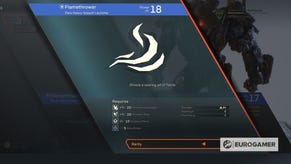Is Anthem's E3 reveal the real deal on Xbox One X?
Digital Foundry's forensic breakdown of BioWare's stunning gameplay demo.
As a 'one more thing' closing zinger for the Microsoft E3 2017 media briefing, the reveal of BioWare's Anthem is hard to beat. A highly polished six-minute gameplay demo - or 'vertical slice' - the code is said to be running on Xbox One X hardware and it looks simply incredible. But from The Witcher 3 to Watch Dogs 2 and Destiny, we've been burnt before by preview teasers that exhibited noticeable downgrades when final code eventually hits stores. Armed with a pristine 4K capture of the trailer direct from Microsoft's on-site media riser, we set out to answer the question - is this the real deal?
Let's bang one nail on the head right away: resolution. Anthem is running at 3840x2160 in this demo, but it does so using checkerboard rendering. Looking through our capture, we noted distinctive artefacting on moving edges, presenting as a faint criss-cross pattern where only half the pixels are shaded. The presentation still looks pin-sharp, even with a compromise that effectively halves native 4K resolution. The technique works for three reasons: firstly, the human eye can't really track precision detail in motion (checkerboarding looks very good on slower motion scenes), secondly 'sample and hold' LCD technology cuts resolved resolution in motion, and finally the tiny pixel pitch on 4K screens makes discerning pixel-level detail extremely difficult any way.
This is not a trivial implementation of the technique by the Frostbite team - it's the result of a concentrated R&D effort that initially aimed to exploit the power of the PlayStation 4 Pro GPU for 4K display owners, and we've already seen a successful roll-out of the technology in BioWare's own Mass Effect Andromeda, running at a lesser 1800p on PS4 Pro. It's not a 'true 4K', but the fact that we're seeing it in the Anthem demo lends more weight to this as an authentic Xbox One X reveal. If there's any doubt as to whether it's a PC version running at max settings, to an extent this puts that to rest - Frostbite aims for full native rendering in its PC incarnation.
DICE has spoken at length about its checkerboard rendering techniques at a recent GDC 2017 presentation. Despite utilising specific ID buffer hardware unique to PlayStation 4 Pro, the 'future work' part of the talk discusses planned workarounds for Xbox hardware and in the Anthem demo, it seems that we now have physical evidence that the technology is in place on Microsoft consoles. Curiously, it also mentions dynamic resolution scaling working well with checkerboarding - but so far, there's no evidence of resolution scaling within the Anthem demo.
That's the first point - as for frame-rates, we only have a 30fps feed from the Microsoft conference, which rules out accurate performance test. From eye-balling the feed though, we did catch some light stutter right at the very end of the demo - as the Freelancers jump into the light - but again, that could well be an issue in the feed sent out. As things stand, the rest of gameplay unfolds with a stutter-free 30fps cadence, and with v-sync engaged. Given all that's going on in this demo - the 4K checkerboarding, huge levels of foliage, physics, and expansive levels with up to four players - a 30fps target is a realistic one. Sustaining this performance target makes sense. After all, there has to be parity with standard Xbox One gamers for online play.
And clearly, with so much going on from a visual perspective, something must give in a real-time rendering scenario. On first viewing, Anthem has a visual impact that makes you wonder if we're in fact looking at a PC version running on max settings. And certainly as far as foliage draw distances, shadow draw, and the volumetric lighting quality goes, that's true. DICE's physically based rendering - first seen in Star Wars Battlefront, and beautifully refined for its sequel - also takes centre stage here, and looks stunning. To what extent this could be noticeably improved on a maxed out PC version remains to be seen.
But there are still caveats that point to console-level settings for the game. Objects and trees are unaffected, but ground textures suffer from noticeable limits in draw distance. This isn't a texture filtering issue either, ground textures materialise into view just before the player walks over them, with normal and specular maps switching in. Again we're staring at a pre-alpha showing, but it's a drawback to the presentation that we'd not expect on PC at ultra settings.
Of course, lighting and effects are exceptional; the Frostbite engine has been continually refined across this console generation, and Anthem sees the whole gamut of the engine's visual features brought into play. There's per-pixel lighting on particles, god rays, and a cinematic bokeh depth of field, mainly used in cut-scenes. However, taking nothing away from the overall visual accomplishment here, console-level settings are evident - for example, screen-space reflections do a good job of mirroring the environment, but lack representation of particles, gunfire or explosions. Yes, it's a nitpick, but we do wonder if there's another level to the rendering setup reserved for the higher PC settings.
Minor pop-in and less-than-perfect effects work can't detract from the sheer impact of the visual package, though. Anthem's rich effects work includes a surfeit of GPU-driven particles, and uses Frostbite's volumetric fog and smoke to add weight to the air. Even the opening hub area is nicely fleshed out, filled with active, bustling NPCs, each with motion capture - though we suspect that a lot of scripting is used here to catch the action from the best angle. One area we're less keen on is the uncanny facial animation - body movements are great, but the initial shot doesn't hold up to the realism of faces used in Battlefield series. And through all that, the motion blur implementation isn't perfect, with missing coverage in some scenes.
It's these imperfections that help to make Anthem's E3 2017 showing that much more authentic, more real, and less likely to end in another downgrade drama. A forensic breakdown of Anthem's visual make-up takes little away from the tremendous impact of the game's visuals, nor from the scale and scope of the remarkably rich, massive vertical world the title is built around. The Frostbite engine once again pushes console visuals to new heights, but what we've seen does point to this being feasible on Xbox One X hardware, with compromises you'd expect to get this running on a six teraflop GPU at a 2160p output. On top of this, bearing in mind that Anthem is a multiplatform title, it'll be fascinating to see how this game will scale up to high-end PCs, and down to PS4 Pro, PS4 and of course, Xbox One. Time will tell, but we can't wait to see more.























.png?width=291&height=164&fit=crop&quality=80&format=jpg&auto=webp)
